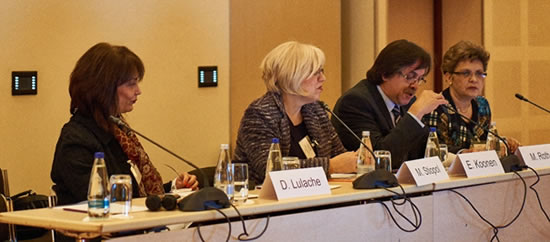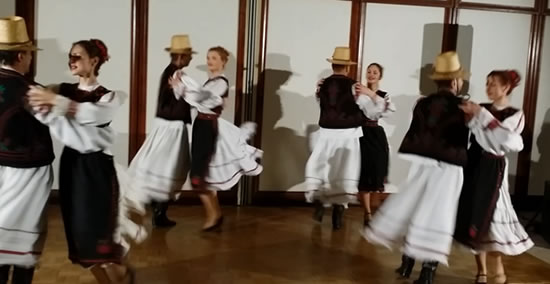
RRFM 2015: From the perspective of Young Generation
In 2015 it was Bucharest’s turn to host the annual European Research Reactor Conference (RRFM 2015), an event organised by the European Nuclear Society (ENS) in collaboration with the Romanian Nuclear Energy Association (AREN), the International Atomic Energy Agency (IAEA), and Électricité de France (EDF). From 19 to 23 April, RRFM 2015 brought together around 200 experts from more than 32 countries that shared their vision and experience on a variety of topics related to the world of research reactors, and presented more than 100 papers and 30 posters.
The agenda began with a Welcome Reception held on 19 April, and was then followed by 3 days of presentations and discussions, and ended with some technical tours. The topics debated in the parallel sessions varied from fuel development and quantification, to innovative methods in analysis and design of the research reactor, fuel fabrication & conversion, Moly99 production to safety and security concerns, back-end fuel cycle, decommissioning, and waste management perspectives. Other sessions were dedicated to new research reactor projects and common international topics.
The conference kicked-off with an opening session during which. Edgar Koonen, of SKG-CEN in Belgium & Chairman of the conference, gave a speech. Then Mihaela Stiopol, President of AREN, and Daniela Lulache, CEO of NuclearElectrica, gave key-note addresses. Daniela Lulache gave a brief overview of Romania’s nuclear programme and its perspective of expanding the programme with the addition of two more nuclear units at Cernavoda site. Ms. Stiopol explained what AREN is and outlined the activities they are doing to gain public acceptance of nuclear energy in Romania. The opening session ended with a speech from Maria Roth, Strategy Development Manager at the Institute for Nuclear Research, in Romania. She highlighted Romania’s nuclear research programme, emphasising the importance given to international cooperation in R&D. She also gave delegates a glimpse of how the Romanian research community is involved in the development of the Gen. IV EUROPEAN Lead Fast Reactor Demonstrator (ALFRED).

From left to right: Daniela Lulache (CEO of Nuclear Electrica, Romania), Mihaela Stiopol (President of AREN, Romania), Edgar Koonen (SKG-CEN Belgium& Chair of the conference), and Maria Roth (Strategy Development Manager, Institute for Nuclear Research, Romania).
The program continued with parallel sessions where, among the many other interesting subjects, Ms. Lin-wen Hu presented a paper entitledthe “STATUS OF THE FLUORIDE SALT HIGH TEMPERATURE REACTOR MATERIALS IRRADIATION TESTS AT THE MIT RESEARCH REACTOR”. Her presentation was a definite highlight of Day 1. It emphasised the importance of following a path towards a commercially viable version of a fluoride-salt-cooled, high temperature reactor, and revealed the status of the first irradiation test done at the Massachusetts Institute of Technology Research Reactor, in the US.
During Day 2, Mr. Belal, from the South African Nuclear Energy Corporation, addressed a world-wide safety related subject. In his paper, “ASSESSMENT OF THE BURNOUT PHENOMENON IN THE SAFARI-1 RESEARCH REACTOR”, he proposed the use of the Sudo scheme of correlations for prediction of CHF conditions in research reactors and assessed the validity of the concept.
Day 3 was dedicated to the social programme, with delegates able to could enjoy the dinner laid on at the Diplomate Ballroom of the Athenee Palace Hilton, in Bucharest. The venue is famous for its great architecture and is situated close to the Romanian Athenaeum Concert Hall, a landmark in the Romanian capital city. The dinner was followed by a traditional folk dancing performance that introduced the distinguished guests into the cultural richness of Romania.

Traditional Romanian folk dancing
On Day 4, one eye-catching paper presented was entitled: “DEVELOPING STRATEGIC PLANS FOR EFFECTIVE UTILIZATION OF RESEARCH REACTORS.” It was delivered by Dr. Ridikas D. from IAEA, who emphasized the need fora strategic plan to ensure a ‘more efficient, optimized, and well-managed utilization’ of research facilities with respect to the IAEA TECDOC 1212. After the presentations and conference sessions RRFM 2015 ended with a closing session chaired by Edgar Koonen and the awarding of the Best Poster Prize.
The next day, delegates had a chance to visit the Cernavoda NPP and the TRIGA Research Reactor at ICN Pitesti. The Cernavoda site features 2 CANDU reactors, with 2 more currently under construction. At Pitesti the TRIGA research reactor and the CANDU nuclear fuel factory are located.
From my personal point of view, having attended RRFM for the first time, I would say that I am very thankful to ENS for providing me with an opportunity to participate as a ‘Young Generation Reporter.’ The conference offered a rich exchange of professional experience and helped make attendees more familiar with the impressive world of research reactors. The opportunity to meet and discuss with top experts from around the world, and ultimately to make new friends, was an enriching experience. I would like to encourage all Young Generation members to attend RRFM 2016, which will be held in Berlin, Germany.
Alin TATU,
Young Generation Reporter,
YGN Romania |

